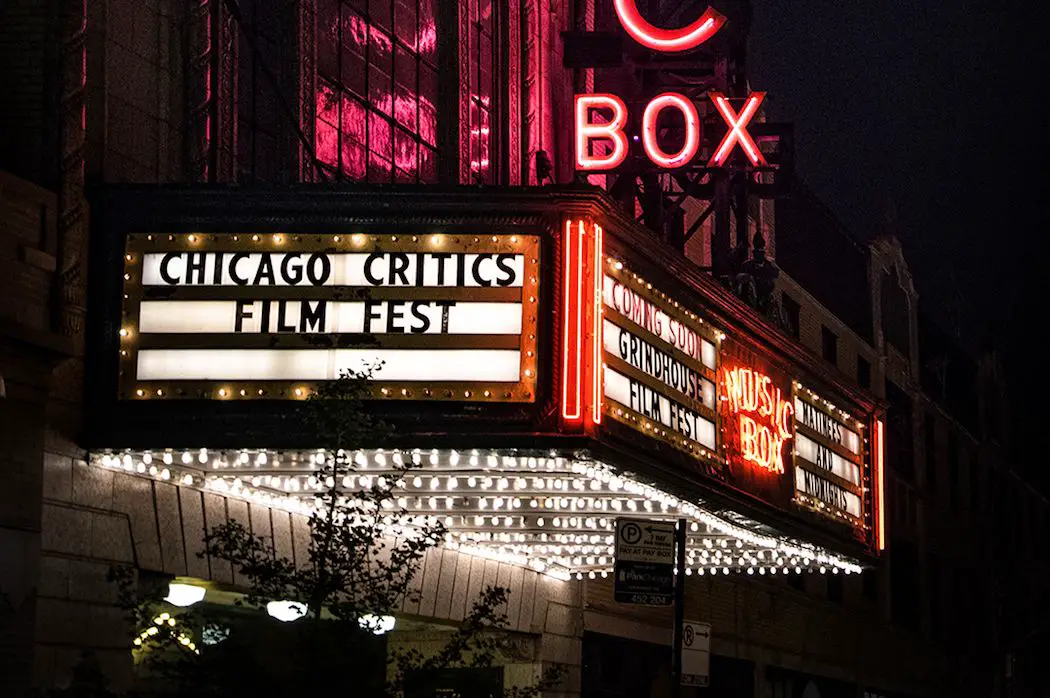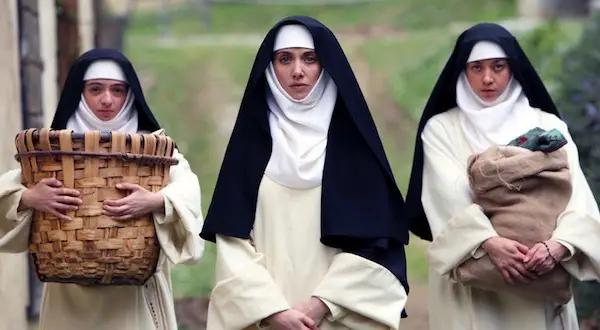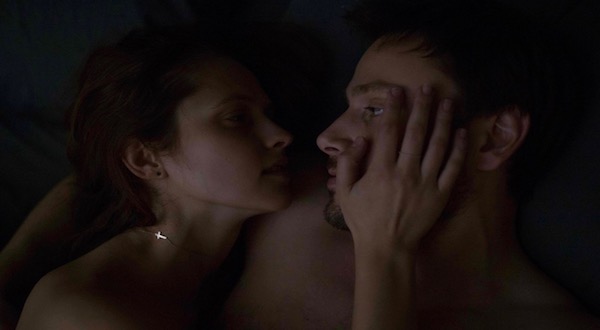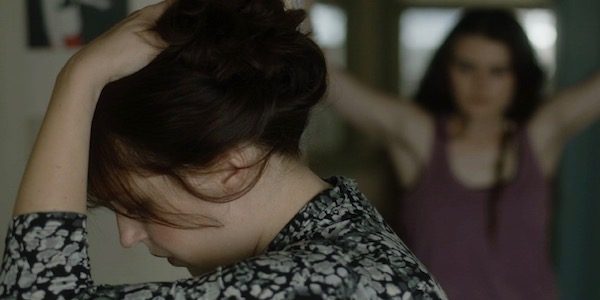Chicago Critics Film Festival 2017: Diary Of A Film Critic

Laura Birnbaum is a proud film critic and writer from…
The red glow from the historic Music Box Theatre sign gleams on car hoods and reflects in the puddles on Southport Avenue. Roars from nearby Wrigley Field echo and dissipate across the urban landscape, and all I can feel is an overwhelming sense of Lester Burnham-level gratitude. People are outside for what feels like the first time in a forever as our annual winter hibernation has come to a close and the warmth from the setting sun beckons us to embrace this May evening in Chicago.
I have been coming to this theater since I was a child. It’s been a Birnbaum family tradition to attend their annual screening of Frank Capra‘s classic, It’s A Wonderful Life. Santa and Music Box organist, Dennis Scott lead the crowd in Christmas Carols as we all sip hot chocolate and collectively hiss when the menacing Mr. Potter appears on screen. It’s an exuberant affair, and Chicagoans know it well.
While this wholesome family tradition is alive and well, my cinephilie inclinations have long since perpetuated my attendance to this marvelous theater during its non-Christmas-themed horror festivals and esoteric docu-short events (among others). Needless to say, if you ever come to the city, The Music Box is the place to be.
The Chicago Critics Film Festival, held at this red-glowing theater, is the only one of its kind; being solely curated by a group of film critics with The Chicago Film Critics Association. The festival features films selected by the association members…
“…comprised of recent festival favorites and as-yet-undistributed works from a wide variety of filmmakers ranging from award winners to talented newcomers chosen by members of the organization,” – Chicago Film Critics Association
Basking in that familiar glow, I walk into the Chicago Critics Film Festival, eager to attend my second year. Last year gave me Oz Perkins‘ here), for which I’m forever grateful. I haven’t the slightest clue what I’m in for this year, but the mystery makes it all the more exciting.
So, what did I walk into, you ask? First up…
The Little Hours
Nunsploitation is a sub-genre of film that I had not been privy to until last week, and I feel all-the-better for having been subjected to it.
The stories of each individual nun, servant, and priest in Jeff Baena‘s The Little Hours is chronicled with great intrigue; their stories assembling together like a titillating Monty Python/Mel Brooks-esque mosaic. The Catholic Church called it “pure trash”, a headline rightfully grabbed by the producers and proudly put on display on the film’s poster for all to see.
For director, Jeff Baena to take a medieval piece of literature such as Giovanni Boccaccio’s “The Decameron,” replace the Florentine language with modern English colloquialisms (“f*ck” being of prominent, post-modern value here), and luminously headline it with some of the best comedy actors out there is, at the very least, commendable. But, is this film all it promises to be?

Yes, it is.
It is, in fact, so much more than promised, that I, a week later, am still basking in the lascivious glory from whence it came. The Little Hours is joy incarnate, featuring an extraordinary cast including, but not limited to: Aubrey Plaza, Alison Brie, Kate Micucci, Dave Franco, John C. Riley, Molly Shannon, Lauren Weedman, Nick Offerman, and Fred Armisen.
Today, those who join the church may do so willingly as they feel called. In the 14th century, however, many nuns were social outcasts; divorcées, unwed mothers, and daughters without suitors – forced into a life of abstinence and faith. The film chronicles the monastic lives of these priests, servants, and nuns, the majority of whom simply don’t want to be there. Apart from the fictionalized (and genius) language choice, the time and place in which the film supposedly takes place is untouched by any form of modernity as we see it today.
The characters in The Little Hours are defined by the rituals they’re called to do by their society, which, in this tale, has extreme(ly hilarious) consequences. Their collective repression spawns boisterous violence, sexual hysteria, and sacrificial witchcraft.
In a Q&A with the actors and director after the film, Baena declares something that re-frames the entire film for me. He states that about 90% of The Little Hours is improvised. All the bawdy stories are, indeed, rooted in the Medieval novellas, but it is the frame of “The Decameron” (i.e. the 10%) on which this improv-heavy film is structured. Can I get an amen?!
As Baena continues, he shares that while studying film at NYU, he dabbled in courses about sexual transgression in the Middle Ages, and thus pursued a minor in Medieval and Renaissance Studies. The Little Hours puts his scholastic knowledge to great use here. This is one of the best comedies I have seen in recent years, and it is definitely the best post-modern nunspoliation comedy I have, or ever will, see.
A parting thought: I think it is our duty, as a society, to give Nick Offerman more castles.
Berlin Syndrome
Sex is officially scary again.
Films, particularly of the horror variety, are often manifestations of our societal fears and anxieties. The symbolic fear of sex and its consequences is by no means a new cinematic motif; with Dracula, Halloween, Fatal Attraction, and the more recent It Follows being some examples, and in Berlin Syndrome, the societal fear being manifested pertains to the strangers with whom we sleep. In the age of hookup and dating apps, the question, ‘how well do you know the person you just hooked up with?’ is all-the-more relevant.
While traveling through Berlin, Australian photojournalist, Clare (Teresa Palmer) takes to exploring the city where she meets Andi (Max Riemelt), a charismatic local teacher with an affinity for art, language, and brown tweed blazers. They spend the day together exploring Berlin, developing their Glenn Close/Michael Douglas-like attraction (pre-stove-top bunny), and all feels right in the world. However, what begins as a sexually-charged tryst between the two of them quickly transforms into a horrifying tale of captivity and confinement.

When I went into this screening, I had recently watched another recent independent Australian release, Hounds of Love, which also features the concerningly en vogue ‘female captive’ narrative at the forefront. Feeling jaded by my experience watching the previous film, I felt tentative about the one I had just sat down to see.
What I ended up watching was something much better than I had expected. Berlin Syndrome veers off from the path more frequently traveled by films of its kind, and for me, it mostly worked. The cinematography, color design, and acting all differ just enough from the thriller zeitgeist to set it apart from the rest.
Where the film falters is in the script. Some of the dialogue is unforgivably bad – making me laugh and roll my eyes in moments that absolutely don’t call for it (a line about pesto, in particular, comes to mind). What I think director Cate Shortland was aiming for with Berlin Syndrome was to create an atmospheric chamber piece that explores the impact that long-term confinement and isolation might have on a person, and she almost achieves it.
La Barracuda
As the curtains in front of the screen lifted in the theater, an image of a woman swimming in a river flooded the screen, and I immediately felt transported into La Barracuda.The camera follows her as she swims off, revealing her close proximity to a factory in the background. The camera rests on this dichotomous ‘nature and industry’ image, and I immediately got the sense that I was watching something truly special.
The film follows a young British woman (and river swimmer), Sinaloa (Sophie Reid) who travels to Austin, Texas to find her half-sister, Merle (Allison Tolman), whose deceased father they share. The family music legacy seems to drive Sinola to include herself in the everyday life of the family, but something more sinister seems to lurk under the surface.

From the very first moment, it is clear that there is something a little off about Sinaloa. She’s abrasive, disrespectful to people around her, and violent. Perhaps it’s too presumptuous to assume that her inappropriate and often abhorrent behavior could not feasibly be permitted by the family, but I presume nonetheless. It became absolutely infuriating to watch Merle (and others) tolerate this recently estranged family members’ actions, and all I kept wanting to know was “why?”.
I won’t say whether or not the answer to this question is brought to light, but I will say that I left the film feeling a little disappointed. What is clear is that Sinaloa’s American Folk music seems to cast a kind of figurative spell on her sister, and I don’t blame her for it. Because here, ladies and gentleman, is one of the main reasons why you should see La Barracuda: the live music. I found myself breathless, tearful (good music does that to me, okay?), and totally blown away by what I was witnessing (which reminds me: If any of you know where I can buy music in this film to then play on a continuous loop for days on end, please let me know).
In addition to the music, I felt enveloped in the juxtaposition between urban and rural landscapes that co-exist in the city of Austin, Texas. Co-directors, Julia Halperin & Jason Cortlund show great strength in presenting a sense of setting and space within the world on screen. In a telling director’s statement, “the escalating tensions between two half-sisters parallel a landscape where development is rapidly erasing the region’s historic identity…but the past doesn’t always quietly disappear.” The blend of old and new as it applies to both the landscape and the family is evident – the opening shot at the river being a striking representation of such.
Ultimately, La Barracuda is a film I liked, but did not love. It is apparent how much of the filmmaker’s heart and soul went into this film, which can only be appreciated, though much of the film felt like an excuse to set up a tone without any real, developed substance. Still, the acting, direction, and music adeptly carries the audience through the complexities of family, secrets, and loyalty.
I mentioned gratitude at the beginning of this journey, and the feeling remains. This festival re-ignites the appreciation I feel to be among film lovers and critics alike in a city that wholly welcomes them. The Chicago Film Critics Association has curated yet another wonderful festival full of titles that would otherwise be difficult to see, or not seen at all, and for that I am grateful.
“We live in a box of space and time. Movies are windows in its walls. They allow us to enter other minds, not simply in the sense of identifying with the characters… but by seeing the world as another person sees it.” -Roger Ebert
Does content like this matter to you?
Become a Member and support film journalism. Unlock access to all of Film Inquiry`s great articles. Join a community of like-minded readers who are passionate about cinema - get access to our private members Network, give back to independent filmmakers, and more.
Laura Birnbaum is a proud film critic and writer from Chicago. When she's not watching independent horror films, she's likely smoking a cigar on a rooftop somewhere, thinking about which indie horror film to watch next.













